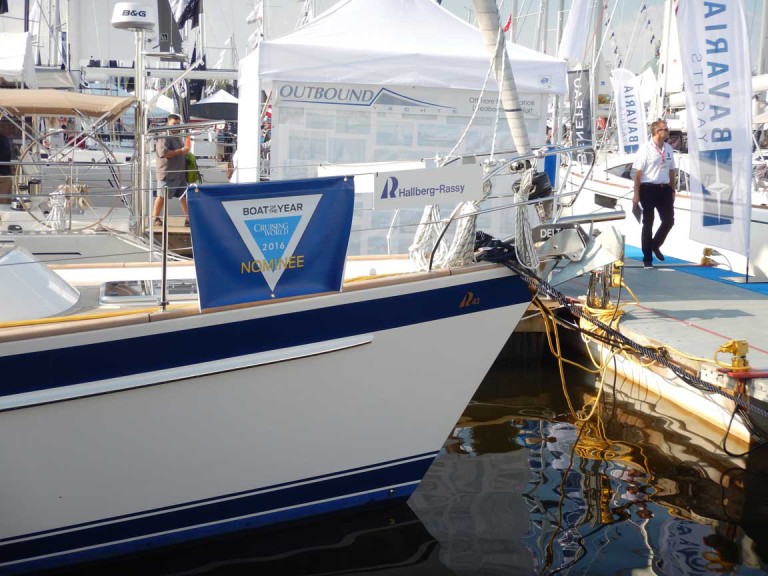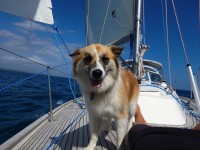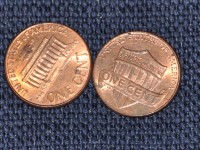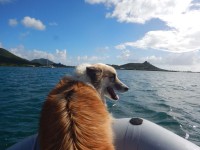We had a quick non-stop 260 mile trip from NYC to Annapolis, via the Delaware Bay and the C&D Canal, and we dropped our anchor in Annapolis the evening before the In-Water Sailboat show. We have wanted to see the show for some time and thoroughly enjoyed two days of looking at some serious high quality cruising boats. Ever since we have had a lot to discuss regarding what Altera V2.0 might look like should we be financially inept enough to buy another hole in the water to throw money at.
For this post, I’ll stick to monohulls and save our real preference for a multihull for another post. For those looking for the ‘coles notes’ my decision (based on the boats we actually saw at the show) would be between the Hallberg Rassy 43 and Hylas 46. Chrissy was also very intrigued by the aluminum hulled Allures 45 and we certainly now understand the popularity of the Outbound 46 among cruisers. The Oyster 475, while nicely finished had too many steps up and down between the cabins, the saloon and the galley so I would go flying when I tripped on a night passage. The Amel 65 was much bigger than we desire but absolutely immaculate. The cruising version of the X-Yachts boat might warrant some further investigation as a performance cruiser. And in an effort to be open minded we even looked at a few high production boats, including one marketed to make perfect ‘Sense‘ and concur it probably does if you are looking for a waterfront condo but don’t want to commit to a fixed address.
Alright, so now that I’m probably getting a lot of flack among those that know that my top choices sell for well north of half a million dollars I should add a few thoughts:
- If you have mediocre dreams, I find it unlikely that your reality will far exceed the dream. Therefore dream big and work towards it. Perhaps then the worst case is your reality will meet you half way.
- We have formulated an opinion on what design characteristics we prefer based on nearly 10000 miles sailed in just over a year, both in sheltered and unsheltered waters. We’ve learned what works for us and what we would like to change.
- We now have enough miles at sea to relate to books and seminars by experienced cruisers. My favourite among the books being Sailing a Serious Ocean by John Kretschmer. There are sound reasons seasoned ocean sailors have these preferences.
- Almost all boats are designed these days for voluminous interior space, creature comforts at the dock, the charter trade and really only for moderate sailing in inland or very near shore sailing – not the long distance sailing we have done. They are built like this because this is what the majority of the market wants.
- Sea going hulls have some compromises in the aforementioned items so that they are also suited to open ocean sailing. Further, they tend to be built only by top quality builders with classy interior wood work and finishes. Offshore cruising is a rather niche market. This makes it hard to find a new ocean going hull shape with a more affordable production boat interior.
- We really aren’t ‘boat snobs’ we just like a hull that sails well and comfortably in a wide range of conditions with a short handed crew. If you were buying a car for off-road use you wouldn’t buy a VW hatchback like we have, you would opt for a Jeep, or if your budget allowed for it, a Land Rover. Unfortunately with new sailboats there doesn’t seem to be a Jeep equivalent, so it is either pony up the cash for the high quality, or refurbish an 80’s era boat when many production boats had sea-going hull shapes and were often built sturdy.
- I read in a personal finance book that a common mentality among middle and lower classes is the ‘I can’t afford it’. Ultimately the easy answer and a lazy approach that requires no further effort. The goal in life is to be happy and if you are happier taking that approach, I am not judging you. Please don’t judge me for thinking that a half million dollar boat is attainable. I am working on ‘how can I afford this’ which will take significant time and effort.
- Currently, we do not have the finances to buy and actively cruise one of these boats, but we are working on how, and when, or whether there is something equally ambitious that we would prefer to do instead.
- Should we buy another boat for future cruising we will also be considering the second hand market and refurbishing a sound hull to a long range cruising standard. For those new to boating it should be pointed out that it can often be a lot cheaper to soak up a few years depreciation on a newer boat than overhaul an older one if you only plan to cruise for 2-5 years. Although admittedly proponents for this case often overlook the opportunity cost of tied up capital.
Both the HR43 and the Hylas 46 are designed by the well respected German Frers who also designed Altera. In the closing of the first chapter of Adlard Coles’ “Heavy Weather Sailing” renowned designer Olin Stevens summarizes that a boat he would be happiest to to meet heavy weather in would be moderate in every way, but as strong as possible. I believe both the Hylas and HR fit this requirement and Altera does too, although Altera slightly favours a bit more of a performance hull and keel shape.
Ultimately, we are very happy with Altera but feel it would be a perfect commuter cruiser – when you have a boat life and a land life that you alternate between. For long term living aboard and passage making there are a few things that it is hard to accommodate on a 34′ boat and a bit more space, although not necessary would be nice. That being said, a bigger boat is much more demanding at sea and we would have been foolish to go much bigger for our first boat. Altera has been forgiving as we have become better cruising sailors.
Even in moderate open water sailing, a moderate hull shape excels in my opinion. The ocean is a couple thousand miles wide and waves travel a long way, so you can often have favourable winds and a mixed up wave pattern created from local winds and swells from far away. A slender hull with a moderate v-shape will ride more comfortably through, and can often be faster than the wide flat bottom designs touted for their performance. Altera has outpaced larger modern designs between islands in the BVIs (owner boats, not charterers) because she can cut through or point higher in a chop. We are generally conservative sailors (we want our stomachs happy when we anchor so we can go for a swim, or happy hour, not lay down and sleep off nausea), so being faster was not because we were pushing the boat to the limits.
Another point of interest is that we almost never sail close hauled, and I sometimes feel foolish for getting a working jib cut to maximize pointing ability. Pointing really high is great for sailing out of the protected waters of Penetanguishene Harbour towards the open waters of Georgian Bay, but in the caribbean, the eastern seaboard and the gulf of St. Lawerence, the wave state is generally sufficient that you want to bear away a few degrees to keep a better angle of attack to the waves. Otherwise, every 6-8 waves when you get the bigger or awkward shaped wave, the hull will slam which is both uncomfortable, hard on the boat and stalls your speed. In these conditions, your progress is really determined by how much leeway the boat makes, and I think the fin keel on the HR 43 and Hylas which is longer fore-aft than Altera’s would track better at sea.
The longer fore-aft keels would also be a bit stronger for those eventual groundings. We’ve only had slow speed groundings while nosing into anchorages, but I was nervous at times in the Bahamas. The area is not well charted and there are a definite lack of skilled repair options. I think we could take a 4 knot grounding but I’m not sure what would happen if we were unfortunate and hit at 6. Newfoundland is another place we are interested in and is also not well charted. That last thing I want is a skinny deep keel that will rip structural members in the hull apart if we hit bottom (I’ve seen it done – both expensive and time consuming to repair if skilled labour is nearby). I’ll leave those for the racers.
From a sail plan and rig perspective, neither of these boats had swept back spreaders which from our year of travels is a strong point. We seem to spend most of our time either close reaching or sailing deep down wind. For the latter we let the main sail out until it hits the spreaders then vang the boom down tight. Then we set a preventer and sheet the sail in until it just stop rubbing on the spreaders. A lot of modern rigs use swept back spreaders which limit how far you can ease the mainsail out which must compromise the deep downwind performance. This is not a compromise I really want to make given how much or our travels have been under these conditions. Further, both of these boats come with an inner forestay, so when conditions deterioriate, you can easily furl the genoa and opt for a smaller, more efficient, and easily deployed head sail. On Altera, we have to drop our working jib, fold it and then raise our smaller jib. While possible at sea if we don’t wait until it is too late, it is a 2 person operation and because we are sleeping shifts, it generally means it is much more attractive to let the off-watch continue resting and just use a less efficient, heavily furled headsail. Plus, the time to make the change means it wont be done if conditions are only forecast to be brisk for 3 or 4 hours.
I am also drawn to the idea of a center cockpit boat. They tend to provide a similar layout down below as Altera which we have found to be extremely functional, but also provides a more private and spacious master cabin at the aft end of the boat. The things we really like about Altera is that we have two straight settees on each side of the boat. These make for a good place to sleep underway and are also very comfortable if we have friends or family for dinner. We have had 6 with no complaints. We have 4 good cupboards in the saloon plus under settee storage that we have dedicated for food storage. You need to remember that when you live aboard you will find yourself wanting baked goods between ports and will want to stow provisions where supplies are plentiful and cost effective to carry you through expensive areas.
So what are some of the things that the Hylas and larger HR offer that I would like to have that we don’t on Altera?
- A bigger galley and a bigger fridge with a better organization system, plus a small freezer. I also want two equally sized sinks. I would also like the galley to be a U-shape so you can brace between two solid cabinets to cook and clean underway. We added a strap to our L-shaped galley which works, but it is still awkward.
- Longer settees. I’m tall and can’t stretch out to read a book on a rainy day. On passage we remove the end cushions which helps, but still the settees are only the same length as I am tall, so I need to curl up a bit so I don’t keep getting my head rocked into the bulkhead in wavy conditions.
- More headroom. I can’t stand up in the head or the aft cabin. I can stand in the center of V-berth as long as I’m directly below the hatch. While I would rather have what we have instead of excessive freeboard to give headroom (a boat must still be a boat, not a condo), larger boats can maintain good proportions, styling and offer the extra couple inches I need so that I’m not bumping my head.
- More storage lockers. Altera had ample storage when we were on Georgian Bay, but when I no longer had a garage and then no longer the trunk of a car to store the tools, spare parts and fluids etc that you only use occasionally it became a jigsaw puzzle. Especially when you add 6 jerry cans of diesel and water because our tankage is a bit modest for the 1500 mile offshore passage. And we actually have a lot more storage than some of the larger boats used in charter service! This is where the HR and the Hylas excel as cabinets and storage cubbies cost money to build, so the high volume production boats simply don’t as weekend warriors don’t need it and would balk at the price. But long range cruisers do recognize the benefit and the need.
- While not a necessity, I can really see the luxury in a centerline aft queen size bed for long duration liveaboard travel as we have done.
- A dining table that doesn’t block access forward and aft when the table leave is up. This will be increasingly important as any next boat will likely also have more ‘regular’ crew members and while tolerable, it is awkward climbing around someone to go between the cockpit and v-berth on our boat if they are working or eating at the table.
- Fuel tankage. Ideally I’d like 1000 mile range under power with separate tanks for redundancy at sea. While this is overkill in the islands, offshore it gives you options and better self suffiency if you have a bad tank of fuel or lose your rig. It also would have allowed us to skip refuelling in the Bahamas at $5.50 a gallon when 5 days later we could get it for $3 in the US.
- Water tankage. Again I would like multiple tanks for redundancy and about 60 gallons per regular crew member, compared with our current 33. Water makers are extremely expensive to operate and I don’t believe they should be considered an option on passage to make up for insufficient tankage. Plus it just another thing to break.
- Mainsheet outside of the cockpit. This is one item I liked when we bought Altera as it made the sailing experience more familar to our Hobie Cat, but at sea it is awkward when you are wearing a tether and moving about the cockpit and limits where people can sit when you have guests. I still want the end boom attachment as mid-boom is not as strong, and admittedly I can have both with a center cockpit layout.
- Enough space on the foredeck for a decent size dinghy. We just downsized our dinghy and it fits on the foredeck now, but in choppy anchorages we are getting wetter as a compromise.
Between the Hylas and the HR, obviously the HR felt more familiar to us so it has an edge in that regard. I thought I would really like the hard dodger on the 43, but it came too far aft and made it tight to squeeze out around the wheel so I bumped my head on the solid frame. It would afford great protection when sitting under it in nasty weather, but the helm is still unprotected. Otherwise, the aft deck with stern rail seats would make for better social space than we currently have and give a good space to let wet gear from the dinghy dry out.
The cockpit on the Hylas felt really high, but gave good sight lines for me. They had tall and strong stanchions that I would really like while at sea. I have read this is a desirable feature to look for when buying an offshore boat, yet this was the first time I’d seen it on a boat under 60′. The interior is finished in a high gloss compared to the satin finish used by HR. The biggest appeal is probably that you can get one without teak decks. While I don’t mind our teak decks, and it is actually a myth that they are really hot in the tropics, they really only look sharp for a decade where as the non-skid can last nearly a lifetime. The other feature I liked was that the table dropped to make another double bed, although it would likely be a seldom used feature.
The disappointment with both of these boats was that they are really intended for a couple with occasional guests and don’t have the cabin configurations available if we were to want to add 2 young regular crew persons….
Fortunately we have a lot of time to continue looking before either could be a reality.




Looks like you are doing indepth reading and being your usual thorough self. So keep that dream alive, you never know what is in your future.
PS the Queen size bed sounds great.
Nan and Grandad. ??
The dream is definitely alive and well. Just need to keep moving. The nights are getting cool on the water again…
Excellent post Jeff!
Thanks, I thought there would be a few like minded that would understand!